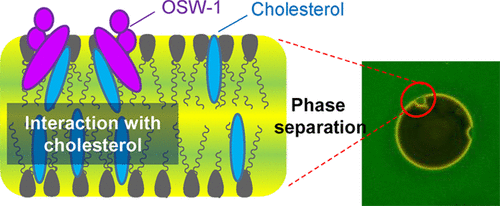Our official English website, www.x-mol.net, welcomes your
feedback! (Note: you will need to create a separate account there.)
Interactions of OSW-1 with Lipid Bilayers in Comparison with Digitonin and Soyasaponin.
Langmuir ( IF 3.7 ) Pub Date : 2020-03-30 , DOI: 10.1021/acs.langmuir.9b03957 Raymond Malabed 1, 2 , Shinya Hanashima 1 , Michio Murata 1, 2 , Kaori Sakurai 3
Langmuir ( IF 3.7 ) Pub Date : 2020-03-30 , DOI: 10.1021/acs.langmuir.9b03957 Raymond Malabed 1, 2 , Shinya Hanashima 1 , Michio Murata 1, 2 , Kaori Sakurai 3
Affiliation

|
OSW-1, a unique steroidal saponin isolated from the bulbs of Ornithogalum saundersiae, has potent cell-growth inhibition activity. In this study, we conducted fluorescence measurements and microscopic observations using palmitoyloleoylphosphatidylcholine (POPC)–cholesterol (Chol) bilayers to evaluate the membrane-binding affinity of OSW-1 in comparison with another steroidal saponin, digitonin, and the triterpenoid saponin, soyasaponin Bb(I). The membrane activities of these saponins were evaluated using calcein leakage assays and fitted to the binding isotherm by changing the ratios of saponin–lipids. Digitonin showed the highest binding affinity for the POPC–Chol membrane (Kapp = 0.38 μM–1) and the strongest membrane disruptivity in the bound saponin–lipid ratio at the point of 50% calcein leakage (r50 = 0.47) occurrence. OSW-1 showed slightly lower activity (Kapp = 0.31 μM–1; r50 = 0.78), and the soyasaponin was the lowest in the membrane affinity and the calcein leakage activity (Kapp = 0.017 μM–1; r50 = 1.66). The effect of OSW-1 was further assessed using confocal microscopy in an experiment utilizing DiI and rhodamine 6G as the fluorescence probes. The addition of 30 μM OSW-1 induced inward membrane curvature in some giant unilamellar vesicles (GUVs). At the higher OSW-1 concentration (58 μM, r50 = 0.78) where the 50% calcein leakage was observed, the morphology of some GUVs became elongated. With digitonin at the corresponding concentration (35 μM, r50 = 0.47), membrane disruption and formation of large aggregates in aqueous solution were observed, probably due to a detergent-type mechanism. These saponins, including OSW-1, required Chol to exhibit their potent membrane activity although their mechanisms are thought to be different. At the effective concentration, OSW-1 preferably binds to the bilayers without prominent disruption of vesicles and exerts its activity through the formation of saponin–Chol complexes, probably resulting in membrane permeabilization.
中文翻译:

OSW-1与脂双层的相互作用与洋地黄皂苷和大豆皂苷的比较。
OSW-1是一种独特的甾体皂苷,从虎眼万年青的球茎中分离出来,具有有效的细胞生长抑制活性。在这项研究中,我们使用棕榈酰油酰磷脂酰胆碱(POPC)-胆固醇(Chol)双层进行了荧光测量和显微镜观察,以评估OSW-1与另一种甾体皂苷,洋地黄皂苷和三萜皂苷,大豆皂苷Bb(一世)。使用钙黄绿素泄漏测定法评估了这些皂苷的膜活性,并通过改变皂苷与脂质的比例使其适合于结合等温线。洋地黄皂苷对POPC-Chol膜的结合亲和力最高(K app = 0.38μM– 1)和在50%钙黄绿素泄漏(r 50 = 0.47)时结合的皂苷-脂质比率最强的膜破坏性。OSW-1的活性略低(K app = 0.31μM –1;r 50 = 0.78),而大豆皂甙在膜亲和力和钙黄绿素泄漏活性方面最低(K app = 0.017μM –1;r 50= 1.66)。在使用DiI和罗丹明6G作为荧光探针的实验中,使用共聚焦显微镜进一步评估了OSW-1的效果。在一些巨型单层囊泡(GUV)中添加30μMOSW-1会引起向内膜弯曲。在观察到50%的钙黄绿素泄漏的较高OSW-1浓度(58μM,r 50 = 0.78)下,一些GUV的形态变长了。用洋地黄皂苷相应浓度(35μM,r 50= 0.47),观察到膜破裂和在水溶液中形成大的聚集体,这可能是由于洗涤剂类型的机理所致。这些皂苷,包括OSW-1,要求Chol发挥其有效的膜活性,尽管据认为它们的机理不同。在有效浓度下,OSW-1优选与双层结合,而不会显着破坏囊泡,并通过形成皂苷-Chol复合物发挥其活性,可能导致膜透化。
更新日期:2020-03-30
中文翻译:

OSW-1与脂双层的相互作用与洋地黄皂苷和大豆皂苷的比较。
OSW-1是一种独特的甾体皂苷,从虎眼万年青的球茎中分离出来,具有有效的细胞生长抑制活性。在这项研究中,我们使用棕榈酰油酰磷脂酰胆碱(POPC)-胆固醇(Chol)双层进行了荧光测量和显微镜观察,以评估OSW-1与另一种甾体皂苷,洋地黄皂苷和三萜皂苷,大豆皂苷Bb(一世)。使用钙黄绿素泄漏测定法评估了这些皂苷的膜活性,并通过改变皂苷与脂质的比例使其适合于结合等温线。洋地黄皂苷对POPC-Chol膜的结合亲和力最高(K app = 0.38μM– 1)和在50%钙黄绿素泄漏(r 50 = 0.47)时结合的皂苷-脂质比率最强的膜破坏性。OSW-1的活性略低(K app = 0.31μM –1;r 50 = 0.78),而大豆皂甙在膜亲和力和钙黄绿素泄漏活性方面最低(K app = 0.017μM –1;r 50= 1.66)。在使用DiI和罗丹明6G作为荧光探针的实验中,使用共聚焦显微镜进一步评估了OSW-1的效果。在一些巨型单层囊泡(GUV)中添加30μMOSW-1会引起向内膜弯曲。在观察到50%的钙黄绿素泄漏的较高OSW-1浓度(58μM,r 50 = 0.78)下,一些GUV的形态变长了。用洋地黄皂苷相应浓度(35μM,r 50= 0.47),观察到膜破裂和在水溶液中形成大的聚集体,这可能是由于洗涤剂类型的机理所致。这些皂苷,包括OSW-1,要求Chol发挥其有效的膜活性,尽管据认为它们的机理不同。在有效浓度下,OSW-1优选与双层结合,而不会显着破坏囊泡,并通过形成皂苷-Chol复合物发挥其活性,可能导致膜透化。











































 京公网安备 11010802027423号
京公网安备 11010802027423号